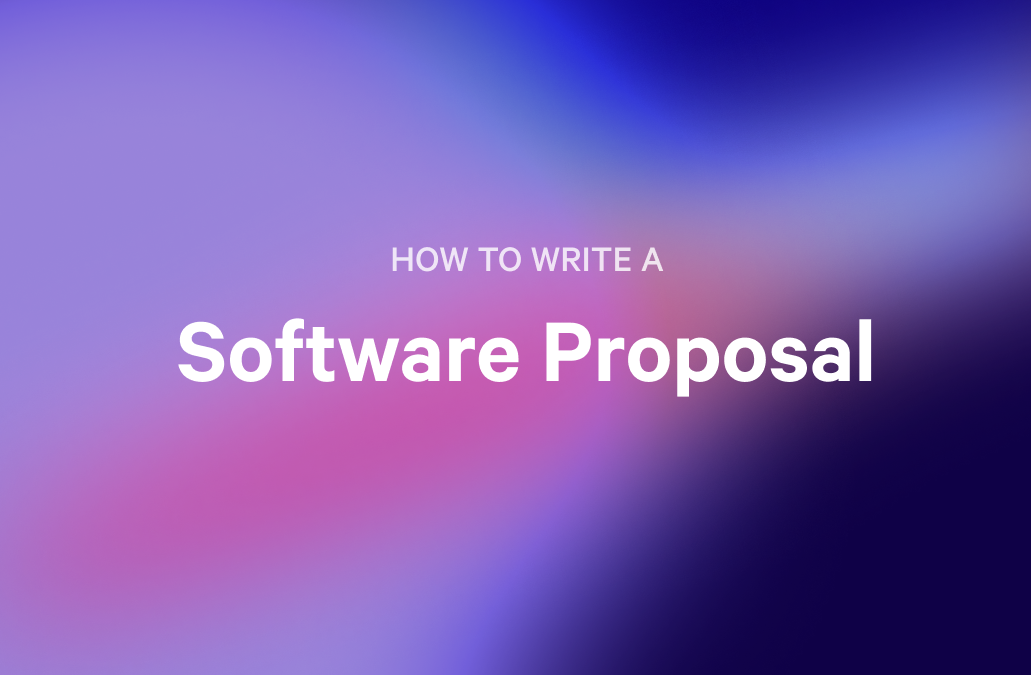Writing a staffing proposal is your chance to show how good your team is at finding and hiring the best people.
But here’s the tricky part: it's not just about finding the right people. Articulating how you do this in a clear and compelling fashion can be tougher than sounds, but we're here to help!
In this article, we'll examine the details that make a staffing proposal stand out. We will show you how to turn a good staffing plan into a solid proposal, with a focus on clarity and effectiveness.
What is a staffing proposal?
A staffing agency proposal is a detailed plan of how your team understands and addresses the challenges of finding the right talent for an organization.
A winning staffing proposal contains more than just a list of potential candidates or job descriptions. It's a full-fledged strategy that shows how your team will find the perfect person for each role.
It answers important questions: How will you determine what the company needs? What steps will you take to find these people? How will you ensure they aren't only qualified but also a good fit for the company culture?
This proposal dives deep into the recruitment process, highlighting your team's industry knowledge, understanding of the job market, and ability to connect with top professionals. It's a chance to show the hard work behind staffing. This includes careful planning, detailed applicant reviews, and a keen eye for talent.
For a closer look at a good example of a staffing proposal, check out our Staffing Proposal Template.
Steps to writing a staffing proposal: key elements to include
When you write a staffing proposal, it should align with the company's needs as closely as possible. You might also want to use the space to challenge the status quo and show them a new way forward. Regardless of your selling approach here, there are some steps you'll need to take and some key elements that should be included in your plan when writing a formal sales proposal. These include:
1. Understand the Company's Needs
The first crucial step in making a great staffing offer is understanding the company beyond its job openings.
Start by learning about the specific roles that need to be filled. But don't just focus on the job titles; look deeper. What are the day-to-day responsibilities of people in these roles, and how is their performance evaluated? You'll also want to learn more about the company's work culture and core values. This matters because you're looking for more than just people who can do the job. You're looking for people who want to grow their careers in that type of environment.
2. Outline your recruitment strategy
Once you understand the company's needs, the next important step in your staffing proposal is clearly outlining your recruitment strategy and your team's ability to find the best candidates.
You should talk about how you intend to screen applicants. Describe how you'll go through the applications. This is where your attention to detail shines through. Do you use special software or a system to evaluate the applications according to specific criteria? Talk about how you review CVs and cover letters. How do you parse applications for relevant experience and other details that show you're on the right track?
A detailed, clear strategy highlights your expertise and your commitment to finding the right people to fill open roles.
3. Highlight your team's expertise
In your staffing proposal, it's crucial to present the strengths and skills of your team. You should do this confidently and optimistically without coming across as boastful. It can be a fine line, admittedly!
Start by mentioning your team's experience in the industry. How many years have they been working in this field? What different backgrounds do they come from? Experience is all about the number of years someone has worked but also their understanding of various industries and job roles.
Next, present your team's customer success stories. These are real examples where your team has done a great job. Maybe your hiring manager filled a particularly difficult position or found a star employee for a company. Do you use an interview coach to develop candidates further prior to their interview, and how does that add value to your prospective client?
By highlighting your team's expertise this way, you're doing more than just listing their skills. You're telling a story about a smart, experienced, and successful staffing team.
We've written a detailed guide about how to write a case study.
4. Showcase your understanding of the market
Your staffing proposal must show your understanding of the current job market and industry trends.
You should talk about what's happening in the job market right now. Are there any particular challenges or new opportunities? Perhaps specific skills are in high demand right now, or more people are working remotely. What new skills are becoming significant in their field? Are there changes in the way companies in that industry are hiring?
Sharing this information indicates your thorough consideration of industry nuances and how they inform your process.
5. Set clear objectives and timelines
You must set clear objectives and timelines in your staffing proposal. This clarity is the key to a smooth staffing process.
Start by defining the main objectives. What exactly does your prospective client want to achieve with this staffing? Do they want to fill a certain number of positions, or are they looking for specific skills? If you set these goals with them early on in the process, will have more control of the work and the timeline. This makes for a better client experience.
Based on this information, outline when in the process you will post job openings, schedule interviews, and finally extend offers to the right candidates (with your client's blessing). It helps for everyone involved to be on the same page and work together towards a common goal.
When you set detailed goals and a timeline, you do more than organize. You're creating a clear, achievable plan. You're saying: "We know what we're doing, and this is how and when we’ll do it." This is a great way to build customer trust.
6. Describe the evaluation process
This section shows that you are careful to find not just any candidate but the right one for the company culture.
To find the right person for a job, deciding what skills and qualifications are needed is the start. You must also consider how well the person will work with the team and the company's style. Soft skills like communication are often as important as technical skills.
Next, describe the criteria you will use. How will you measure these skills and qualities? Maybe you have a point system for different skill sets. Or you might highlight your use of a task-oriented or testing-based interview to measure soft skills and determine how well someone would fit into the current workforce.
However you plan to evaluate candidates, having a clear plan and being able to communicate the results is critical to help you win the business.
7. Include a communication plan
A clear communication plan is a vital part of your staffing proposal. It's like a common thread that keeps everyone involved and informed throughout the recruitment process.
You need to explain your overall approach to staying in contact. It's about making the company feel like you're a partner in the process and not just an observer. Will you send updates through weekly emails or hold a meeting every two weeks? Choose effective methods but also take into account candidates' busy schedules.
Next, outline exactly what these updates will include. Will you tell them how many candidates you've found, how the interviews are going, or the candidate feedback? Also, talk about how you'll be staying in touch to ensure you and the company's expectations are aligned.
8. Budget and cost analysis
You must prepare a detailed financial plan and cost analysis in your staffing proposal. Being open about the costs involved will help you build trust.
Show your prospective clients exactly what they can expect to spend throughout the process. Consider any "overhead" costs you have, like applicant tracking software, running background checks, and posting job requisitions on different job boards. You can even offer prospects choices about how many postings you place on their behalf or how long you'll leave them open on various sites.
The more detailed you can be about costs upfront, the more it saves you and your prospect from having to renegotiate later - or worse, your prospective client getting upset about a surprise bill.
Example of a staffing proposal template
Our staffing proposal template guides you step-by-step and ensures your proposal is clear, professional, and engaging. It shows you everything you need to include, from the company's needs to your recruitment plan. Using professional proposal templates saves you time, creating an easily customizable yet consistent and visually impressive document every time. Our template does this.
This is what our template includes:
- Executive Summary: This is the first impression of your proposal. This project description outlines what readers can expect, grabbing their attention.
- Understanding Your Needs: This section shows you understand the company's needs. It's about showing empathy and expertise right from the start.
- Your Priorities: Focus here on what is most important for the company. It's about showing that you understand and are willing to address their key concerns.
- 12-Month Goals: This part looks forward. Describe what you plan to achieve next year, mixing ambition with practicality.
- Our Approach: Explain your unique strategy and methods. This is where you highlight how your way of working benefits the client.
- Services Overview: Detail the services you offer. It's a clear breakdown of what you can do for the company and the tangible benefit it brings.
- Our Achievements: Share your success stories. This builds credibility by showing your track record.
- Our Team: Introduce your team members and their skills. This adds a personal element to the proposal while building trust.
- Investment Required: Clearly outline the costs. Being upfront about the investment builds trust from the start.
- Call to Action: Encourage the reader to take the next step, whether a meeting or a call.
- Contact Information: End with your contact details. It's an invitation for further communication and connection.
Alternatively, you can try our AI proposal generator for free to create a professional looking proposal in minutes.
Final Thoughts
Writing a staffing proposal is like telling a story. It explains how you can meet an organization's staffing needs with expertise and understanding. Every part of your proposal should show that you can meet- and beat- the company's expectations.
Now, it's time to put what you've learned into action.
Use the Qwilr staffing proposal template as a starting point, impressing your prospects right from the start. You’ll see the time it saves and the difference it makes to your process and client acquisition.
About the author

Brendan Connaughton|Head of Growth Marketing
Brendan heads up growth marketing and demand generation at Qwilr, overseeing performance marketing, SEO, and lifecycle initiatives. Brendan has been instrumental in developing go-to-market functions for a number of high-growth startups and challenger brands.
FAQs
The ideal format for a solid staffing proposal is clear and easy to understand. Start with a brief overview in the summary and then clearly explain how you understand the company's needs. Follow this with your recruitment strategy, insights into your team's expertise, and the state of the job market. End the proposal with a clear budget breakdown and a clear call to action. This format covers all the essential points in a straightforward and engaging way.
A proposal should be long enough to cover all the essential details and be easy to read. Typically 5 to 10 pages long. This length lets you explain your strategy and demonstrate your expertise without adding unnecessary information.
To establish an understanding of the company's culture, you want to do some research. Look at the company's website (especially if they have a careers page) and social media posts. What do they write about, and how do they speak about themselves? Learn about the company's mission and core values as well. You can then weave these elements into your proposal and staffing strategy to ensure you're going to not only win the business but also find the right candidates for the open roles you'll need to fill.


